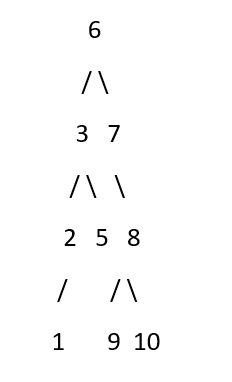Python Tutorial
Python OOPs
Python MySQL
Python MongoDB
Python SQLite
Python Questions
Plotly
Python Tkinter (GUI)
Python Web Blocker
Python MCQ
Related Tutorials
Python Programs
How to Determine if a Binary Tree is Height-Balanced using PythonHeight Balanced Binary TreeA binary tree data structure called as a "height-balanced binary tree," or "balanced binary tree," has left and right subtree heights of each node that are at most one unit apart. This is a crucial characteristic that ensures the efficiency of insertions and deletions as well as the balance of the tree. The length of the longest path from root node toward a leaf node, measured in edges, is used to determine a binary tree's height. A height-balanced binary tree is significantly more effective than an imbalanced binary tree since the height of the tree is ensured to be logarithmic in the numbers of node of the tree.
Examples of Height Balanced Binary Tree
The root node in this instance is number 6. The heights of the right subtree (7, 8, 9, 10) and the left subtree (3, 2, 1) are both 2. The fact that there is just a one-height difference between the left and right subtrees indicates that the tree is height-balanced. The balancing of a tree can really alter over time as node are added or removed, despite the fact that the figure depicts a balanced tree. Algorithms like AVL trees, red-black trees, and splay trees are employed to ensure that the tree stays balance also after alterations in order to retain its equilibrium. How to tell if a Binary Tree is Balanced in Height?We can create a recursive method that measures the height of the tree and returns False if a left and right subtrees' heights differ by much more than one in order to assess whether a binary tree is height-balanced. Here is an illustration of a Python implementation: Code Explanation The is balanced function in this example checks to see if the left and right subtrees' heights vary by more than one and returns False if they do. The height method returns the height limit of the left and right subtrees + 1 to determine the height of the tree. By supplying the tree's root node as the parameter, you may use the is balanced results to calculate whether a binary tree is height-balanced. The trees is height-balanced if the program runs True; else, it is not. Program for Height Balanced Binary TreeFor an example of a height-balanced binary tree, see this Python programme: Code Output: The binary tree is height-balanced.
Next TopicHow to Empty a Recycle Bin using Python
|
 For Videos Join Our Youtube Channel: Join Now
For Videos Join Our Youtube Channel: Join Now
Feedback
- Send your Feedback to [email protected]
Help Others, Please Share










